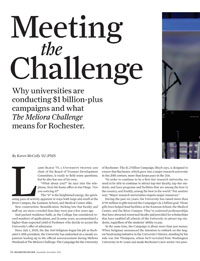Features
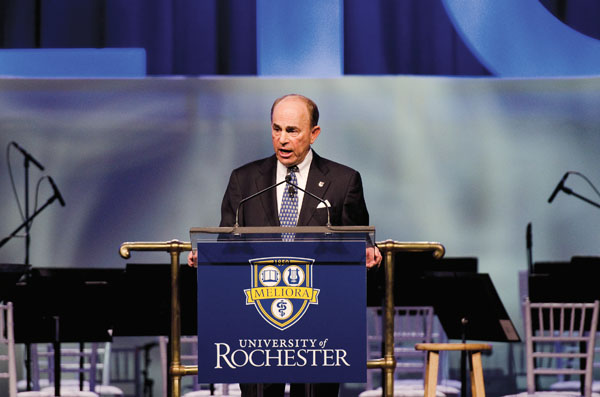 LEADING THE WAY: Trustees Ed Hajim ’58, board chair (above), and Larry Bloch ’75 [below, shown with his son, Matt ’13S (MBA)], were on hand to help launch The Meliora Challenge, noting that the comprehensive fundraising initiative is vital to Rochester’s future as a top research university. (Photo: Adam Fenster)
LEADING THE WAY: Trustees Ed Hajim ’58, board chair (above), and Larry Bloch ’75 [below, shown with his son, Matt ’13S (MBA)], were on hand to help launch The Meliora Challenge, noting that the comprehensive fundraising initiative is vital to Rochester’s future as a top research university. (Photo: Adam Fenster)Larry Bloch ’75, a University trustee and chair of the Board of Trustees Development Committee, is ready to field some questions, but he also has one of his own.
“What about you?” he says into the telephone, from his home office in San Diego. “Are you noticing it?”
The “it” is the heightened energy, the quickening pace of activity apparent in ways both large and small at the River Campus, the Eastman School, and Medical Center alike.
New construction. Beautification. Parking lots that faculty and staff say are more crowded than they were just a few years ago.
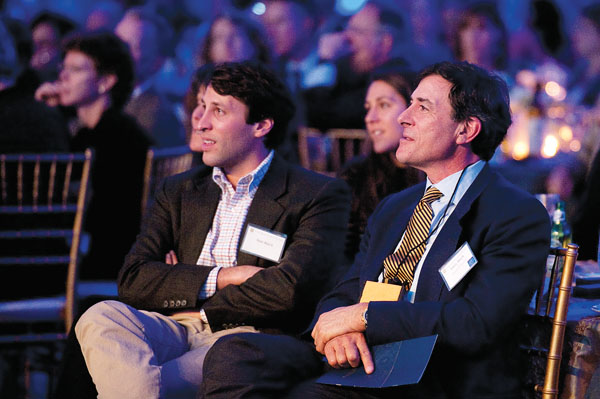 (Photo: Adam Fenster)
(Photo: Adam Fenster)And packed residence halls, as the College has considered record numbers of applications, and in some years, accommodated a higher-than-expected yield of freshmen who decide to accept the University’s offer of admission.
Since July 1, 2005, the day Joel Seligman began his job as Rochester’s 10th president, the University has embarked on a steady expansion leading up to the official announcement during Meliora Weekend of The Meliora Challenge: The Campaign for the University of Rochester. The $1.2 billion Campaign, Bloch says, is designed to ensure that Rochester, which grew into a major research university in the 20th century, more than keeps pace in the 21st.
“In order to continue to be a first-tier research university, we need to be able to continue to attract top-tier faculty, top-tier students, and have programs and facilities that are among the best in the country, and frankly, among the best in the world.” Put another way: “Major research universities require major resources.”
During the past six years, the University has raised more than $759 million in gifts toward the Campaign’s $1.2 billion goal. Those gifts have helped fund facilities at the Eastman School, the Medical Center, and the River Campus. They’ve endowed professorships that have attracted renowned faculty and provided for scholarships that have enabled all schools of the University to attract top students, regardless of the students’ ability to pay.
At the same time, the Campaign is about more than just money. When Seligman announced the intention to embark on the largest fundraising initiative in the University’s history, standing by his side was Jim Thompson, whom he’d recruited from Washington University in St. Louis and made Rochester’s new senior vice president and chief advancement officer.
“We’ll raise this money,” says Thompson. “That’s less the issue.”
The Meliora Challenge, he says, is really about “building a network to promote engagement and the University.” Building that network requires external relations—the marketing and promotional efforts to help define the University, its mission, and its ethos to a wide range of friends, from members of the local community to far-flung graduates. It’s an effort that’s been undertaken in a complementary fashion by University Advancement and a reorganized and strengthened office of University Communications, with the goal of helping to generate support that’s sustainable well into the future.
“Rochester, like many great research universities, has recognized that an external relations program isn’t an option,” Thompson says. “It’s an absolute requirement to be a vital, healthy, impactful university. We had definitely kept our light under the bushel.”
Rochester has not traditionally focused on fundraising because for decades, it didn’t have to. Says Ed Hajim ’58, the chair of the University’s Board of Trustees: “When I was in school in the 1950s, the endowment was the fourth or fifth largest in the country. There was a mentality at the school—it was pervasive—that we didn’t need to fundraise.”
In the 1980s, the University invested heavily in venture capital and private partnerships, a strategy that yielded poor results, adds Hajim, the past chairman and CEO of the investment banking firm Furman Selz. Hajim was instrumental in turning that strategy around, generating results more in line with the needs of the University.
Meanwhile, Rochester had begun falling behind, as many other universities were dramatically ramping up their fundraising efforts. In recent years, campaigns in excess of $1 billion—and, just in the last 10 years, far in excess of $1 billion for some of the nation’s larger research universities—have become a trend. Schools such as Cornell, Columbia, and Stanford have all launched campaigns in the $4 billion range in just the last five years. Public universities such as the University of Virginia, UCLA, and the University of Colorado—seeking to reduce their dependence on taxpayer support—have followed suit. Private colleges, accounting for size, have been no less ambitious, with institutions such as Mount Holyoke, Ithaca College, and others conducting campaigns ranging from $100 million to more than $300 million.
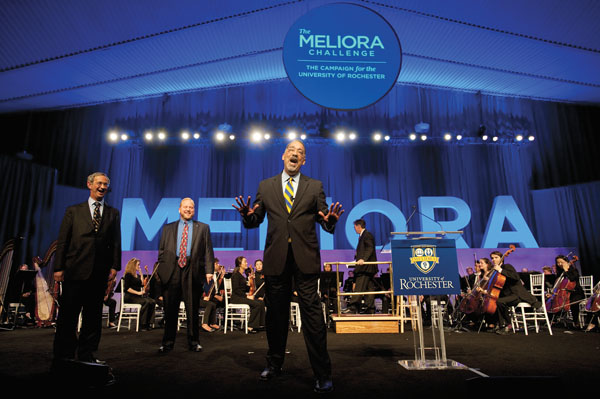 LEADERS: Vice President Paul Burgett leads President Joel Seligman and Chief Advancement Officer Jim Thompson, along with
700 guests, in The Genesee during the program for The Meliora Challenge. (Photo: Adam Fenster)
LEADERS: Vice President Paul Burgett leads President Joel Seligman and Chief Advancement Officer Jim Thompson, along with
700 guests, in The Genesee during the program for The Meliora Challenge. (Photo: Adam Fenster)What’s driving these large sums? Echoing Bloch, Rae Goldsmith, a senior staff member at the Council for the Advancement and Support of Education, or CASE, says rapidly advancing and changing technologies are major factors. As a result, she adds, fundraising is “critical” for research universities like Rochester, with strong programs in the sciences, and in particular, in the health sciences.
“It’s important for these research universities to be able to provide their students and their faculty the same modern facilities as other institutions,” she says.
The Board of Trustees hired Seligman in 2005 with development as his principal mandate, says Jonathan Schwartz, the senior associate vice president for advancement and the director of University campaigns, who, like Seligman and Thompson, also came from Washington University, in 2007. There
, Thompson and Schwartz had been part of a fundraising operation that had helped catapult the St. Louis university—once known as a local “streetcar college”—to national recognition. Thompson had been second-in-command of a program that has since completed a $1.55 billion campaign, the fifth largest in the history of higher education at the time of its launch. He helped build the infrastructure—the major gifts program, the capital projects program, the regional development programs, and programs in corporate and foundation relations, stewardship, and donor relations—to drive the campaign.
Since arriving at Rochester, he’s spearheaded a similar effort. There are now approximately 200 staff members working for University Advancement and extending its reach locally and nationally.
Hajim says the change has been stark. “We had a somewhat unsophisticated advancement effort,” he says of years past. “We have a sophisticated advancement effort now.”
For the past several years, Thompson, Schwartz, advancement officials at each of the University’s schools and units, professional staff in alumni relations as well as alumni volunteers, and trustees have been engaged in a coordinated effort to contact and engage thousands of Rochester’s more than 90,000 living alumni from across disciplines and schools. It’s an effort to tap into an institutional culture, to draw out its ethos and establish among the members of a far-flung family a sense of loyalty and stewardship.
Schwartz says campaigns are about “really focusing collectively on articulating—or rearticulating—what the mission is and what the pressing needs and opportunities are.”
Goldsmith says this type of advanced planning has become standard practice among the educational institutions CASE serves.
“There’s much more thoughtful legwork at the front end of campaigns today. They’re planned more strategically, addressing not only immediate needs, but positioning for the long term.”
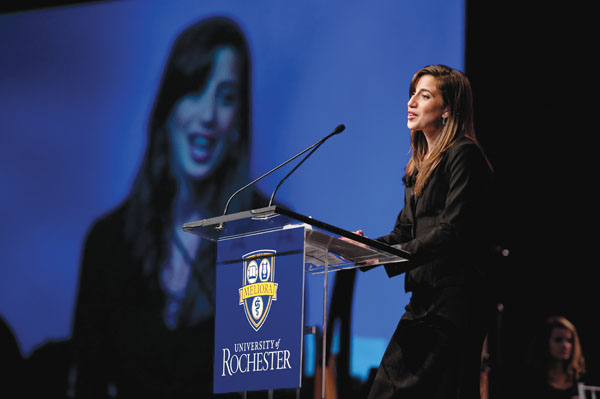 LEARN: “I literally walk around campus, thinking ‘how did I ever get to be this lucky?’ ” chemistry major Emily Hart ’12 told guests at a celebration marking the launch of the Campaign. (Photo: Adam Fenster)
LEARN: “I literally walk around campus, thinking ‘how did I ever get to be this lucky?’ ” chemistry major Emily Hart ’12 told guests at a celebration marking the launch of the Campaign. (Photo: Adam Fenster)The legwork for The Meliora Challenge began with each of the units of the University presenting coordinated strategic plans to the president and the board’s Strategic Planning Committee, chaired by Chair Emeritus Robert Goergen ’60. What’s ultimately brought to fruition depends as much on the priorities and visions of donors as it does on the sum total of resources raised.
In the end, it’s about ownership. Who owns the private university?
“The people who own the University are the alumni, the local community leaders, the parents,” says Thompson. “Because the University of Rochester, like any great research university, isn’t going to be sold. It isn’t going out of business. It’s not going to move. We’re in some ways the ultimate stakeholders in this community.”
“My dream is that by the time I’m buried in Mt. Hope Cemetery, and if God came down from the heavens and said, ‘Who’s responsible for this place?’ we’d have tens of thousands of people immediately raising their hands. That’s a healthy university. That’s a vibrant university.”
That depends on a philanthropic culture that has to be developed broadly.
Hajim, for his part, sees progress.
Take the reunions.
“At our 50th Reunion, we raised a record amount of money,” he says of the Class of 1958, noting that the record didn’t last.
“The Class of ’59 had never beaten the Class of ’58 at any reunion. Well, they beat us. And at the Class of ’60, they raised an absolute record.”
In the days leading up to Meliora Weekend 2011, Hajim offered his prediction that this year’s reunion giving would far surpass last year’s record.
Says Bloch: “I think that to the extent that we achieve our goals, it becomes a little bit self-fulfilling. We have to be smart enough to realize that when we finish this Campaign, what we’ve really done is taken step one toward building that philanthropic culture.”
“My opportunity to be at Rochester came in part on the backs of people who came before me,” he adds, noting that even full tuition “didn’t cover anything close to the real cost of getting an education at Rochester.
This is really our responsibility.”
